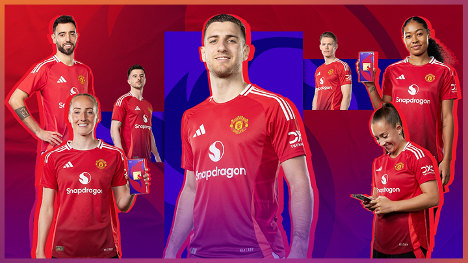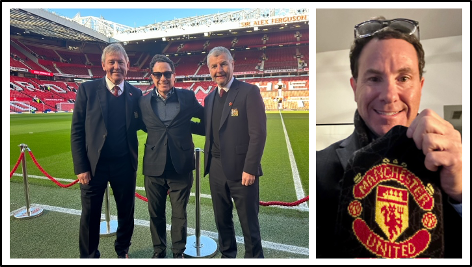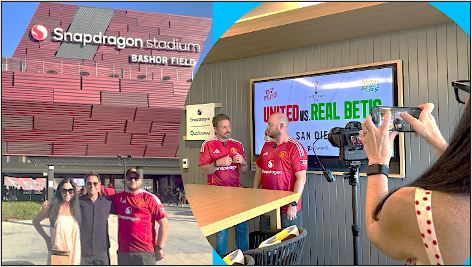
Qualcomm has been putting a lot of energy into sports partnerships to elevate its Snapdragon brand globally. This strategy prioritizes key placements of the Snapdragon name across various sports properties and teams, such as renaming San Diego State’s stadium to Snapdragon Stadium in 2021. A major milestone in this initiative is Snapdragon’s recent placement on the front of Manchester United’s jersey. This sponsorship goes beyond mere logo placement and brand visibility; it extends to technology that enhances fan experiences through better connectivity, use of data, and interactivity within stadiums.
The ultimate goal is to forge lasting, meaningful connections with fans. As it does this, Qualcomm draws on its experience as a key player in mobile computing, networking, and telecom to make its sports sponsorships an extension of its brand identity.
In a recent Game Time Tech podcast with us at Moor Insights & Strategy, Qualcomm CMO Don McGuire explained how these partnerships go beyond mere logo impressions. They focus on integrating Snapdragon technology into experiences that deeply connect with both the team and fans worldwide. As McGuire put it, “Our Manchester United partnership is how we come together with one of the most revered sports franchises in the world, and how we build to scale for the Snapdragon brand—from the awareness all the way through to affinity and advocacy.”

Flashback to Manchester
In November 2023, I had the opportunity to go behind the scenes at Manchester United. In a meeting in Manchester, England, Qualcomm took the opportunity to review its marketing strategies and highlight the advantages of being Manchester United’s front-of-jersey sponsor. The visit made a big impression on me, starting with an insightful tour of the legendary Old Trafford, a site with a rich history dating back to its origins as a cricket ground in 1854. The current building, sometimes called the “Theater of Dreams,” has seen some of the most memorable moments in world football. The tour included a visit to the Carrington training facility, offering a glimpse of the grounds where Paul Pogba and Marcus Rashford honed their skills as young players.
A key takeaway from my visit was seeing how Qualcomm’s technology will be integrated into the stadium and training facility, improving connectivity both inside and outside the venues. As McGuire mentioned, the potential impact “could revolutionize how fans interact with the gameday environment through augmented reality and other digital innovations.” The partnership is a key element of broader efforts to revitalize Old Trafford and Carrington, with Qualcomm aiming to modernize the venue through advancements in IoT, sustainability, and security.
Qualcomm is hardly alone in gravitating to European football rather than American sports leagues for such a marquee partnership. Data from Sponsor United indicates that brand sponsorships in European football grew by 22% this season, more than doubling last season’s increase. In contrast, the five major professional sports leagues in the U.S. saw an average sponsorship growth of 10.5% since 2022. The top European leagues and their historic clubs have also gone to great lengths to cultivate fanbases in Asia, Africa, and the Americas.

Visit to San Diego
In July 2024, my travels took me to San Diego, where I visited other sports venues showcasing Qualcomm’s technology. At Petco Park, Snapdragon-powered sensors handle real-time data to optimize the venue’s functionality. Fans benefit from high-speed Wi-Fi, allowing them to stay connected, share updates, and access real-time game statistics. The augmented reality experience in the Padres Hall of Fame adds an interactive and immersive element.
While I was there, Snapdragon Stadium hosted a landmark event in which Qualcomm unveiled its Snapdragon logo on the front of Manchester United’s jerseys, marking the public launch of their partnership. The fun continued when Qualcomm announced that Microsoft’s Copilot+ PC logo will appear on the back of Man United player jerseys. This decision highlights the Copilot+ PC collaboration between Qualcomm and Microsoft—something that my colleague Anshel Sag has written about extensively.
Meanwhile, the Qualcomm-Man U. collaboration highlights how sponsors can seamlessly integrate their products into event experiences, transforming traditional venues into smart stadiums. McGuire highlighted the importance of not just meeting but surpassing fan expectations. “The ability to showcase our technology is a critical element to any partnership,” he explained. He used the example of AR: “We bring the shirt [jersey] to life with an augmented reality experience. Just hold your phone up to the logo, and you can dive into Old Trafford . . . and explore all aspects of the club and our brand.”
On the same day as the introduction of the Snapdragon jerseys, Manchester United secured a victory in its exhibition match, coinciding with Qualcomm’s announcement of a very successful financial quarter. It felt like everything was coming to fruition at once.
Data Perspectives — Qualcomm, Manchester United, and Fans
To sum up this partnership, it brings a new level of connectivity and data access to the club, its players, and fans, all powered by Qualcomm’s skill in deploying connectivity and handling mobile data. For its part, Qualcomm plans to use data analytics to understand fans better and enhance their overall experience.
For Manchester United, some of the data collected will be used to enhance player performance and refine game strategies. Other data will facilitate more personalized fan engagement, ensuring that interactions with the club are more relevant and meaningful. Meanwhile, improved connectivity at Old Trafford—supported by Qualcomm—should also bolster the club’s marketing efforts, enabling more effective targeted campaigns.
From the fan perspective, Manchester United supporters will enjoy personalized content and an enhanced matchday experience. Qualcomm’s technology will provide real-time data analytics, offering better insights into player stats and game performance. And the improved connectivity ought to ensure that fans stay connected throughout the match, accessing live updates and interactive features that deepen their connection to the game. All in all, this partnership is poised to redefine the fan experience at the stadium.
Full Time
It’s clear that the partnership between Qualcomm and Manchester United goes beyond the typical surface-level sponsorship. That said, to ensure a solid return on Qualcomm’s investment—which is well into nine figures for the three-year front-of-jersey deal—it’s essential that all the data and technology discussed above actually delivers the value both parties expect.
As this partnership evolves, the expectations are significant. Qualcomm and Manchester United have the opportunity to reframe how technology integrates with sports, potentially setting a new standard for future collaborations focused on fan experience and data-driven insights.






















































































